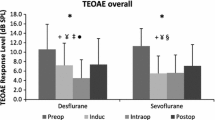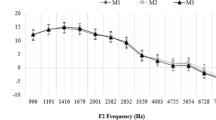Abstract
The aim of the present study was to compare pre- and post-operative otoacoustic emission examinations of patients who experienced surgery under hypotensive anaesthesia using distortion product otoacoustic emission (DPOAE) and transient evoked otoacoustic emission (TEOAE). Forty-one patients, admitted to our tertiary centre for nasal valve surgery, were prospectively and randomly assigned into two groups. Hypotensive group included 20 patients, while control group included 21 patients. All investigators and patients were blinded to anaesthesia assignment throughout the course of the study. DPOAEs and TEOAEs were performed before surgery and repeated after 15 days in both groups. In control group, DPOAE–DP1 levels per frequency increased significantly in the post-operative period when compared with the pre-operative values in all patients. However, DPOAE–DP1 levels decreased significantly in hypotensive group. Similarly, DPOAE–SNR levels per frequency decreased significantly in hypotensive group. In conclusion, we have observed that under the influence of hypotensive general anaesthesia, the amplitudes of OAEs are affected.




Similar content being viewed by others
References
Miller JM, Ren TY, Nuttall AL (1995) Studies of inner ear blood flow in animals and human beings. Otolaryngol Head Neck Surg 112:101–113
Quirk WS, Dengerink HA, Coleman JK, Wright JW (1989) Cochlear blood flow autoregulation in Wistar-Kyoto rats. Hear Res 41:53–60
Brown NJ, Nuttall AL (1994) Autoregulation of cochlear blood flow in guinea pigs. Am J Physiol 266:458–467
Ren T, Avinash GB, Nuttall AL, Miller JM, Laurikainen EA, Quirk WS (1994) Dynamic response of cochlear blood flow to occlusion of anterior inferior cerebellar artery in guinea pigs. J Appl Physiol 76:212–217
Degoute CS, Preckel MP, Dubreuil C, Banssillon V, Duclaux R (1997) Sympathetic nerve regulation of cochlear blood flow during increases in blood pressure in humans. Eur J Appl Physiol Occup Physiol 75:326–332
Harel N, Kakigi A, Hirakawa H, Mount RJ, Harrison RV (1997) The effects of anesthesia on otoacoustic emissions. Hear Res 110:25–33
Preckel MP, Ferber-Viart C, Leftheriotis G, Dubreuil C, Duclaux R, Saumet JL, Banssillon V, Granry JC (1998) Autoregulation of human inner ear blood flow during middle ear surgery with propofol or isoflurane anesthesia during controlled hypotension. Anesth Analg 87:1002–1008
Avan P, Büki B, Petit C (2013) Auditory distortions: origins and functions. Physiol Rev 93:1563–1619
Dreyer M, Migdal H (1990) Transient medium- and deep-tone hearing disorders following spinal anesthesia. Reg Anaesth 13:138–141
Fog J, Wang LP, Sundberg A, Mucchiano C (1990) Hearing loss after spinal anesthesia is related to needle size. Anesth Analg 70:517–522
Gultekin S, Ozcan S (2002) Does hearing loss after spinal anesthesia differ between young and elderly patients? Anesth Analg 94:1318–1320
Panning B, Mehler D, Lehnhardt E (1983) Transient low-frequency hypoacousia after spinal anaesthesia. Lancet 2:582
Panning B, Lehnhardt E, Mehler D (1984) Transient low-frequency hearing loss following spinal anaesthesia. Anaesthesist 33:593–595
Fog J, Wang LP, Sundberg A et al (1990) Hearing loss after spinal anesthesia is related to needle size. Anesth Analg 70:517–522
Galley N, Klinke R, Oertel W, Pause M, Storch WH (1973) The effect of intracochlearly administered acetylcholine blocking agents on the efferent synapses of the cochlea. Brain Res 64:55–63
Klinke R, Oertel W (1977) Evidence that GABA is not the afferent transmitter in the cochlea. Exp Brain Res 28:311–314
Klinke R (1986) Neurotransmission in the inner ear. Hear Res 22:235–243
Kettembeil S, Manley GA, Siegl E (1995) Distortion-product otoacoustic emissions and their anesthesia sensitivity in the European starling and the chicken. Hear Res 86:47–62
Hauser R, Probst R, Harris F, Frei F (1992) Influence of general anesthesia on transiently evoked otoacoustic emissions in humans. Ann Otol Rhinol Laryngol 101:994–999
Hess MM, Lamprecht A, Kirkopoulos S, Fournell A (1991) Messung evozierter otoakustischer emissionen zu verschiedenen zeitpunkten einer intubationsnarkose. Folia Phoniatr (Basel) 43:68–73
Ferber-Viart C, Preckel MP, Dubreuil C, Banssillon V, Duclaux R (1998) Effect of anesthesia on transient evoked otoacoustic emissions in humans: a comparison between propofol and isoflurane. Hear Res 121:53–61
Enns J, Gelb AW, Manninen PH, Murkin JM, Farrar JK (1993) Cerebral autoregulation is maintained during propofol-nitrous oxide anesthesia in humans. Can J Anaesth 39:A43
Hoffman WE, Edelman G, Kochs E, Werner C, Segil L, Albrecht RF (1991) Cerebral autoregulation in awake versus isoflurane anaesthetized rats. Anesth Analg 73:753–757
Wang LP, Fog J, Bove M (1987) Transient hearing loss following spinal anesthesia. Anesthesia 42:1258–1263
Gultekin S, Ozcan S (2002) Does hearing loss after spinal anesthesia differ between young and elderly patients? Anesth Analg 94:1318–1320
Finegold H, Mandell G, Vallejo M, Ramanathan S (2002) Does spinal anesthesia cause hearing loss in the obstetric population? Anesth Analg 95:198–203
Ok G, Tok D, Erbuyun K, Aslan A, Tekin I (2004) Hearing loss does not occur in young patients undergoing spinal anesthesia. Reg Anesth Pain Med 29:430–433
Acknowledgments
No financial support was received for this paper. Authors indicate that they do not have a financial relationship with the organisation that sponsored the research.
Conflict of interest
The authors declare no competing interest.
Author information
Authors and Affiliations
Corresponding author
Rights and permissions
About this article
Cite this article
Aladag, I., Kaya, Z., Gurbuzler, L. et al. The effects of hypotensive anaesthesia on otoacoustic emissions: a prospective, randomized, double-blind study with objective outcome measures. Eur Arch Otorhinolaryngol 273, 73–79 (2016). https://doi.org/10.1007/s00405-014-3488-2
Received:
Accepted:
Published:
Issue Date:
DOI: https://doi.org/10.1007/s00405-014-3488-2




